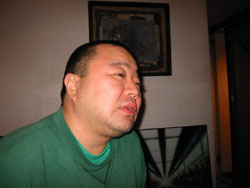Kyoichi Tsuzuki (journalist and artist, born 1956 in Tokyo)
Aomi Okabe: I saw your installation of Toba International Sex Museum (Roadside Japan) (1996) at Yokohama Triennale, which was quite graphic. I heard that you purchased the collection of the defunct Toba Sex Museum. Is that right?
Kyoichi Tsuzuki: I thought it was a pity that the museum had to close down, simply because people didn’t pay a visit. Nobody considers this museum as a subject of art. However, when it is viewed in a particular context, like Yokohama Triennale, audiences will be convinced that this is certainly what art is. When is was exhibited at some suburb area in Toba, it didn’t catch any attention and even worse, was labeled as an inappropriate subject. The museum ran over 20 years, but it wasn’t even introduced in a town guide. Society can be cruel towards this kind of culture. Therefore, it is really important that this exhibition is recognized as a form of art. To be honest, I strongly believe that some museums, like the National Museum of Ethnology or the Mie Prefectural Art Museum, should buy this exhibition instead of wastiong their money on some absurd impressionist paintings. I had to spend my own money for this exhibition, so it is hard work to rent storage and stuff. I had hoped that some art university would support me.

photo Aomi Okabe
Okabe: Well, how much would it be if I were to buy?
Tsuzuki: It is incredibly cheap. I’d say, as cheap as a Mercedes Benz car. Nonetheless, people would agree that 30 million yen for a car is reasonable, or even a house for 100 million yen, but it is a different matter when it comes to buying a sex museum. I mean, not many people are prepared to spend their money on art. I think, if you had 100 million yen, you could buy all the sex museums in Japan.
Okabe: Your exhibition was one of the major pieces in the Yokohama Triennale, right?
Tsuzuki: Yeah, but as soon as the show ended I was told to bet out of the site without a word of thanks. Vast amount of people paid a visit to the Triennale, but the artists didn’t receive any payment in the end, not even a penny. Art seems really fashionable, but when it comes to money, it’s a very sensitive and complicated issue. I think this is the most outdated and sordid part of the Japanese contemporary art scene. There are a lot of cool museums, but they still carry on with this pre-modern system. I can easily spot the error in today’s art system, because I’m an outsider in a way.
Okabe: In Japan, it is common that many public art museums are restricted from paying artists. In contrast, art museums abroad are known to pay the artists even if it is only a small gesture.
Tsuzuki: Exactly. I think the Japanese art system is unrealistic. It is unfair that artists don’t get paid back for their art.You must rent storage, because you get kicked out of the museum immediately after the show. It means that the more you create, the more you suffer. It’s crazy! And it’s very rude to the artists, don’t you think? In the past, the artists used to gain their prestige by exhibiting in museums, as a result, the price of their art pieces increased. This then encouraged an attitude amongst museums of supporting the artist. However, this method is no longer true these days. Before you enter the art business, you must understand that today’s Japanese art runs on a hidden system which forces the artists to work voluntarily without any financial aid, otherwise you will be disappointed for sure.
Okabe: Let’s talk about eroticism. Eroticism was used as a symbol in celebration of the harvest in the past, but it exists today as a way of popular visual expression, which appears to be very unique to Japan. For example, in many other countries eroticism is a taboo subject for religious reasons.
Tsuzuki: If you look at eroticism, Japan must have the most creative approach. I think each nation has its own talent. For example, Chinese people are the best at cooking, Italian’s, world’s best car design, or Japanese, eroticism. I had an exhibition called “Satellite of Love” in London which included the interior design of a Japanese brothel which shocked audiences. It was already a form of conceptual art. Nevertheless, it looks cool when it is presented in a form of exhibition. In Paris I also presented an exhibition on love hotels. Despite its controversy, a lot of people came to see it. In fact, for most of the foreign architects who visit Japan, the love hotel is their most desired sight-seeing spot.
Okabe: Eroticism in Japan has been embedded in art, tradition and history. However, since western culture and modernism were introduced, it has come to be regulated and somewhat suppressed. People tend to limit themselves with morality. But from the perspective of some foreigners, Japan appears to be such a different world that they can critique it without risk.
Tsuzuki: But in the end it seems to me that Japanese people are pleased because foreigners are assessing them. This mentality hasn’t improved since the ukiyo-e era. To me, the most fascinating thing is to discover something new by taking risk. There is no point in praising what has already been praised before. I think there are only 2 types of artist; boring but receives lots of money and do whatever you want in your free time, or interesting but can’t make any money out of it. Life is a lot easier if you let yourself believe the latter option is impossible.
Okabe: What was the reason which made you decide to introduce the unknown places and people of Japan in your work?
Tsuzuki: It’s only been in the past 10 years that I have started to get to know Japan. I used to work abroad for a long time, so that I couldn’t realize how great a country Japan really is. In fact, Roadside Japan was originally intended only as a short series. I was having some drinks with the director of “SPA!” magazine, saying that there are eccentric people existing in the countryside. We said, let’s write a column about them! That was the beginning and I got fascinated with it. The series lasted for about 5 or 6 years and I still travel around even though the series has ended. Don’t you at least want to go around every bit of your own country? If you live in Tokyo, you could start at least by travelling over the 23 wards. During the trid, for example, I met an old man who runs an anti-gravity laboratory. He’s been saying that he is only one step away to completing his UFO for over 40 years. Everybody laughs at him, but he can’t be more serious. It is very important for me to meet these kinds of people. It doesn’t mean that I need to imitate them, though. At times when I seem about to fall, thinking about them gives me courage. This is why I am writing books about them to introduce these kinds of people to the world.
Okabe: In your view, the country of Japan can be described as an `adorable girl without any make-up, not too beautiful but pretty enough.’
Tsuzuki: Don’t you agree? I know it doesn’t sound very cool. Take a look at Japanese architecture, for example. I’m sure that there are more people who go to love hotels that people who own a house designed by Tadao Ando. However, there has not been a single architect or design magazine issued on love hotels so far. This culture is neglected by media even though it is one of the most recognizable features around us. I could easily publish a book like TOKYO STYLE, but it would be called TOKYO EXCEPTIONS since the number of cool buildings in Tokyo is rather limited. I think it is important to find this sense of reality.
Okabe: Lastly, would you like to make a comment on today’s art scene in Japan and the lack of art spaces?
Tsuzuki: I consider the art museum as a place for collecting, exchanging, and exhibiting art works. If you don’t have any pieces to exchange, then, you can borrow something by paying ridiculous amounts of money. But for an artist, these is no compliment worth more than someone buying even one small piece of your work. In my opinion, the only way for museums to survive is to support young artists. Say Mori Art Museums spent 600 million yen for the exhibition called “HAPPINESS”. If you had that amount of money, you could buy approximately 100 to 200 Japanese contemporary artists’ works. I really don’t understand why despite there being so many museums in Japan, there is not a single art museum you can name where you can be guaranteed of seeing real contemporary art. It is absurd that even though Japan does not have this provision, a huge amount of money is still being consumed in vain. I think artists suffer to create their work; therefore, those who are not artists must undertake the burden of providing good galleries and art museums for them. If you are willing to work with artists, it is only fair that you take the same risks as well.
(At Kyoichi Tsuzuki office, November 26th, 2003, translated by Mei Matsubara, revised by Emma Ota)
都築響一 アーティスト
岡部あおみ:都築さんの『鳥羽国際秘宝館(珍日本紀行)』(1996)の過激なインスタレーション作品を横浜トリエンナーレで見せていただきました。閉館していた鳥羽のSF秘宝館を買われたんですね。
都築:人が来なくて閉館してて、あまりにももったいないので、譲っていただいたのですが、みんなバカにしてアートだなんて思ってない訳ですよ。だけど横浜トリエンナーレみたいな場に移せば、アートだと思って並んでくれる。鳥羽の商店街にあると、エロだと思われて誰も行かない。20年やってても観光地図にさえ載せてもらえない。そういう冷たい扱いがある。だから美術かどうかはどの場所に置かれるかがすごい大きい。でも本当は、民族学博物館や三重県立美術館が買わなきゃだめ。くだらない印象派の絵とか買ってないで。僕が自費で預かったから、倉庫まで借りて大変です。美大とかで買って欲しいよ。
岡部:あの、もし買うとしたらおいくらでしょうか?
都築:いやもうすごく安いもんですよ。ベンツ一台分くらい。だけど3000万円の車や一億の家は安いといって買う人はいても、秘宝館を買う人はいない。つまり美術にお金出す人はいないということですね。一億あったら日本全国の秘宝館をすべて買えると思いますけど。
岡部:横浜トリエンナーレの目玉作品のひとつになりましたよね。
都築:だけど一言のねぎらいの言葉もなく、終わった瞬間に早く撤去してくださいって言われただけです。浜トリにはかなり人が入ったのに、アーティストには一銭の還元もなかった。あのお金はどこに行ったのか。アートはかっこいいみたいだけど、お金を巡る状況はすごく複雑。日本の現代美術が一番遅れてて汚い部分ですね。かっこいい美術館は沢山あるけど、前近代的システムがまかり通っている。僕は外部の人間なので、そういうシステムの矛盾が見えるんですよ。
岡部:日本の公立美術館は作家へのギャラは出せない規約になっているところが多いですが、海外の美術館だと安くても一応は出しますよね。
都築:出しますよ。完全にお役人体質で切実感がまったくない。一方アーティストは作品を出すだけ出して買い上げもしてもらえない。新作を作って展覧会が終わったらドカンと返される。倉庫代を払うわけだから、やればやる程損をする。すごくおかしいし、失礼でしょう。昔は美術館に出すことで箔がついて、自分の絵の値段が高くなった。だから美術館は出してやるという態度だったけれど、今はもう通用しない。アーティストに負担をかけ、一方的なボランティアを強いて、現代美術館のほとんどが成立しているという裏側のしくみを理解してこの業界に入らないと、すごくがっかりするよね。
岡部:エロスに関してですが、かつて豊穣の象徴でもありましたが、エロスの表現が、大衆的な視覚表象として存在しているのはとても日本的ですね。海外だとキリスト教のタブーもあってあからさまではない。
都築:エロに関しては世界一クリエイティヴですよ。僕が思うに民族はそれぞれ得意分野がある。中国人はご飯作らせたら世界一とか、イタリア人は車のデザイン世界一とか、日本はやっぱりエロスでしょ。この前までロンドンで、イメクラのインテリアという展覧会をやってたんですけれど、ヨーロッパの人は呆然としています。もろコンセプチュアルアートみたいなものですから。しかも展覧会としてやればすごくかっこいいアートに見える。パリではラブホテルの展覧会をやったのですが、信じられないという感覚があってもみんな見にくるし、日本に来る建築家なんかが一番見たがる建築はラブホテルですよ。
岡部:日本には基本的にエロティックな美術や伝統や歴史があるのだけれど、西洋的な文化やモダニズムの導入もあって、ある時期から管理されてきたり、自分自身が倫理的に自己管理するようになってしまった。ただ日本のすべてが、外国人にとっては何のリスクもなく評価出来る遠い遠い世界なんですね。
都築:だけど結局何でも、外人が評価するから日本人が喜ぶわけでしょ?これは浮世絵の時代のメンタリティから変わってない。僕達にとって一番面白い事は、リスクを負って何かを探すこと。人が褒めてるものを褒めてもしょうがない。僕が思うに2種類しかないんです。つまんないけどお金を沢山貰って、余った時間に好きな事をやるか、おもしろいけど儲かんないか。おもしろくて儲かるのは、ありえないと思っていれば気が楽ですよ。
岡部:日本の知られざるすごい人々や場所を紹介したいという気持ちをもつようになられたきっかけは?都築:僕自身、日本のことを知るようになったのはここ10年くらいです。ずっと外国の仕事が多くて本当の日本の面白さをしらなかった。『珍日本紀行』も最初は『SPA!』の編集長と飲んでる時に、田舎って変なの多いから、短期連載でやろうということになり始めたら、だんだん面白くなった。5、6年連載を続けて終わった後も、自費でずっと今でも行ってます。せめて自分の国ぐらい全部まわりたいと思いません?東京に住んでるなら、23区一応全部まわるとか。たとえば日本の田舎を巡っていたら、田舎で反重力研究所を作ってUFOの完成まであと一歩とか言いながら40年もやっているおやじに会うわけですよ。周囲の笑い者だけど、本人の目は澄んでいる。そういう人を見ていると「ああそうだよな」って思う。そういう人達に出会うことがすごく大事で、僕にとっての引き止め役。真似をしろというのではなく、転びそうになった時に引き止めてくれるいいもの。そういう人達を紹介したくて、僕は本をつくっているわけですよ。
岡部:そういう視点で、都築さんにとって日本という国は、「愛すべきすっぴんで、あまり美人ではないけど、ちょっとはかわいい」となるのですね。
都築:そういう国だと思いませんか?かっこ悪いけど。建築にしたってラブホテルに行ってる人の方が、安藤忠雄さんの家に住んでる人より数では圧倒的に負けない。でも建築・インテリア雑誌では絶対取り上げてくれないし完全無視。はるかに僕達の生活に身近なものでしょ。例えば『TOKYO STYLE』みたいな本は沢山作れますけど、ものすごくかっこいい東京の住まいは少ないので「例外東京」。自分にとってのリアリティがどこにあるのかということですよね。
岡部:最後に今の日本・美術館状況やアートスペースが足りないということについてはいかがでしょう。都築:美術館は収蔵品を交換して展覧会をする物々交換の世界。でも、自分の所に作品がなかったら、交換出来ないので、高いお金をだして借りる。作家にとってどんな褒め言葉よりも小さい絵を一枚買ってくれるほうがいい。若い作家や同世代の作家をサポートしていくことでしか本来美術館は成り立たないですよ。もし森美術館の「ハピネス」展に6億円かかったなら、それで日本の現代作家の100人や200人分の作品が買える。日本にはこんなに美術館があるのに、ここへ行けば現物の現代美術が見られるという場所がないのは、すごく不思議です。そういう大事な場所が日本になくて、お金だけがめちゃくちゃ使われているのは異常ともいえる。作家は身を削って作品を作ってるんだから、作家にならないやつは、身を削って自分のギャラリーなり、美術館を作ってやらなきゃだめ。アーティストと仕事をするなら、自分も同じリスクを払わないと信用ができない。
(麹町の都築響一オフィス、2003年11月26日 参加者:芦立さやか、足立圭、池内麗佳、小黒加奈子、高木嘉代、高橋僚佑、中村美久、直塚郁、テープ起こし:直塚郁 + 中村美久)
